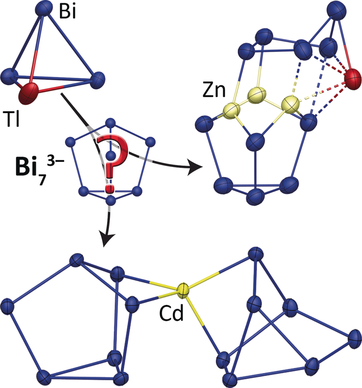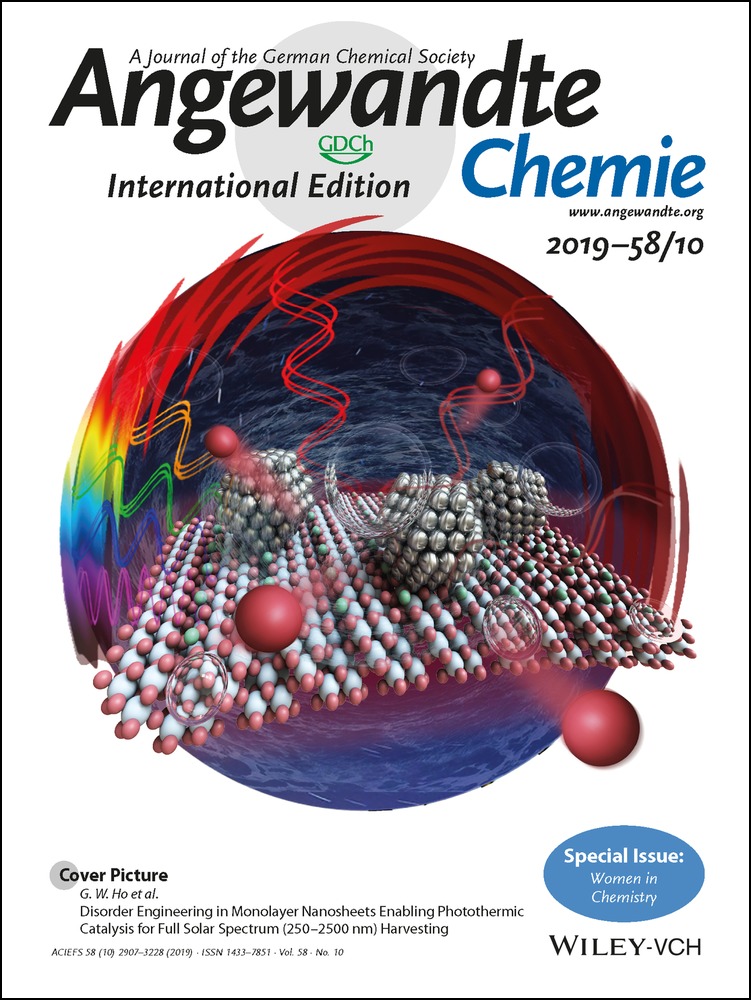Polybismuthide Anions as Ligands: The Homoleptic Complex [(Bi7)Cd(Bi7)]4− and the Ternary Cluster [(Bi6)Zn3(TlBi5)]4−
Dr. Niels Lichtenberger
Fachbereich Chemie und Wissenschaftliches Zentrum für Materialwissenschaften, Philipps-Universität Marburg, Hans-Meerwein-Straße 4, 35043 Marburg, Germany
Search for more papers by this authorProf. Dr. Werner Massa
Fachbereich Chemie und Wissenschaftliches Zentrum für Materialwissenschaften, Philipps-Universität Marburg, Hans-Meerwein-Straße 4, 35043 Marburg, Germany
Search for more papers by this authorCorresponding Author
Prof. Dr. Stefanie Dehnen
Fachbereich Chemie und Wissenschaftliches Zentrum für Materialwissenschaften, Philipps-Universität Marburg, Hans-Meerwein-Straße 4, 35043 Marburg, Germany
Search for more papers by this authorDr. Niels Lichtenberger
Fachbereich Chemie und Wissenschaftliches Zentrum für Materialwissenschaften, Philipps-Universität Marburg, Hans-Meerwein-Straße 4, 35043 Marburg, Germany
Search for more papers by this authorProf. Dr. Werner Massa
Fachbereich Chemie und Wissenschaftliches Zentrum für Materialwissenschaften, Philipps-Universität Marburg, Hans-Meerwein-Straße 4, 35043 Marburg, Germany
Search for more papers by this authorCorresponding Author
Prof. Dr. Stefanie Dehnen
Fachbereich Chemie und Wissenschaftliches Zentrum für Materialwissenschaften, Philipps-Universität Marburg, Hans-Meerwein-Straße 4, 35043 Marburg, Germany
Search for more papers by this authorGraphical Abstract
A coordination compound with intact Bi73− ligands, namely the homoleptic complex [(Bi7)Cd(Bi7)]4−, and the ternary cluster [(Bi6)Zn3(TlBi5)]4− were prepared through in situ degradation of the binary Zintl anion (TlBi3)2−. The compounds provide a glimpse into a possible formation pathway of the polycyclic polybismuthide, the follow-up chemistry of which has been unprecedented to date. Both title compounds were further studied by means of DFT methods.
Abstract
We present the results from a reactivity study of the binary anion (TlBi3)2− towards Group 12 metal compounds MPh2 (M=Zn, Cd, Hg) to gain access to coordination compounds of polycyclic polypnictide molecules such as Bi73− or Bi113−. The coordination chemistry of these polybismuthide cages has been unprecedented to date, while it has been known for a long time for the lighter Group 15 anions Pn73− (Pn=P, As, Sb). The use of (TlBi3)2−, previously shown to release Tl under certain conditions in situ, resulted in the formation of the first heterometallic polyanion in which a nortricyclane-type polybismuthide coordinates a transition-metal atom, [(Bi7)Cd(Bi7)]4−. Reactions with the lighter Group 12 metal precursor yielded the uncommon ternary cluster [(Bi6)Zn3(TlBi5)]4−, most likely representing a reaction intermediate, and at the same time hinting at the formation of the nortricyclane-shaped cage. Quantum-chemical studies provide deeper insight into the stability trends of the [(E7)M(E7)]4− anion family and reveal a complex bonding situation in [(Bi6)Zn3(TlBi5)]4−, which features both localized and multi-center bonding.
Supporting Information
As a service to our authors and readers, this journal provides supporting information supplied by the authors. Such materials are peer reviewed and may be re-organized for online delivery, but are not copy-edited or typeset. Technical support issues arising from supporting information (other than missing files) should be addressed to the authors.
| Filename | Description |
|---|---|
| anie201812473-sup-0001-misc_information.pdf2.1 MB | Supplementary |
Please note: The publisher is not responsible for the content or functionality of any supporting information supplied by the authors. Any queries (other than missing content) should be directed to the corresponding author for the article.
References
- 1
- 1aJ. E. Huuhey, E. A. Keiter, R. L. Keiter, Inorganic Chemistry—Principley of Structure and Reactivity, 4th ed., Addison Wesley, Reading, 1993;
- 1bT. F. Fässler, Zintl Phases—Principles and Recent Developments, Springer, Heidelberg, 2011;
10.1007/978-3-642-21150-8 Google Scholar
- 1cA. F. Holleman, N. Wiberg, Lehrbuch der Anorganischen Chemie, 102nd ed., Walter de Gruyter, Berlin, 2007;
10.1515/9783110177701 Google Scholar
- 1dC. E. Housecroft, A. G. Sharpe, Inorganic Chemistry, 4th ed., Pearson, Upper Saddle River, 2012;
- 1eS. Dehnen, Clusters – Contemporary Insight in Structure and Bonding, Springer, Cham, 2017.
10.1007/978-3-319-52296-8 Google Scholar
- 2
- 2aS. Scharfe, F. Kraus, S. Stegmaier, A. Schier, T. F. Fässler, Angew. Chem. Int. Ed. 2011, 50, 3630–3670; Angew. Chem. 2011, 123, 3712–3754;
- 2bR. S. P. Turbervill, J. M. Goicoechea, Chem. Rev. 2014, 114, 10807–10828; early and most recent examples for this As and Sb chemistry:
- 2cD. G. Adolphson, J. D. Corbett, D. J. Merryman, J. Am. Chem. Soc. 1976, 98, 7234–7239;
- 2dH.-G. Von Schnering, D. Fenske, W. Hönle, M. Binnewies, K. Peters, Angew. Chem. Int. Ed. Engl. 1979, 18, 679–680;
10.1002/anie.197906791 Google ScholarAngew. Chem. 1979, 91, 755–756;
- 2eM. Kaas, N. Korber, Z. Anorg. Allg. Chem. 2017, 643, 1331–1334;
- 2fA. E. Seitz, M. Eckhardt, S. S. Sen, A. Erlebach, E. V. Peresypkina, H. W. Roesky, M. Sierka, M. Scheer, Angew. Chem. Int. Ed. 2017, 56, 6655–6659; Angew. Chem. 2017, 129, 6755–6759.
- 3
- 3aR. S. P. Turbervill, J. M. Goicoechea, Chem. Commun. 2012, 48, 6100–6102;
- 3bA. R. Jupp, J. M. Goicoechea, Angew. Chem. Int. Ed. 2013, 52, 10064–10067; Angew. Chem. 2013, 125, 10248–10251;
- 3cR. S. P. Turbervill, J. M. Goicoechea, Inorg. Chem. 2013, 52, 5527–5534;
- 3dR. S. P. Turbervill, A. R. Jupp, P. S. B. McCullough, D. Ergöçmen, J. M. Goicoechea, Organometallics 2013, 32, 2234–2244.
- 4C. Knapp, B. B. Zhou, M. S. Denning, N. H. Rees, J. M. Goicoechea, Dalton Trans. 2010, 39, 426–436.
- 5
- 5aO. J. Scherer, Angew. Chem. Int. Ed. Engl. 1990, 29, 1104–1122; Angew. Chem. 1990, 102, 1137–1155;
- 5bO. J. Scherer, C. Blath, G. Wolmershäuser, J. Organomet. Chem. 1990, 387, C 21–C24;
- 5cO. J. Scherer, Acc. Chem. Res. 1999, 32, 751–762;
- 5dH. Krauss, G. Balázs, M. Bodensteiner, M. Scheer, Chem. Sci. 2010, 1, 337–342.
- 6C. M. Knapp, B. H. Westcott, M. A. C. Raybould, J. E. McGrady, J. M. Goicoechea, Chem. Commun. 2012, 48, 12183–12185.
- 7
- 7aC. Schwarzmaier, S. Heinl, G. Balázs, M. Scheer, Angew. Chem. Int. Ed. 2015, 54, 13116–13121; Angew. Chem. 2015, 127, 13309–13314;
- 7bN. Arleth, M. T. Gamer, R. Köppe, S. N. Konchenko, M. Fleischmann, M. Scheer, P. W. Roesky, Angew. Chem. Int. Ed. 2016, 55, 1557–1560; Angew. Chem. 2016, 128, 1583–1586;
- 7cC. Schoo, S. Bestgen, M. Schmidt, S. N. Konchenko, M. Scheer, P. W. Roesky, Chem. Commun. 2016, 52, 13217–13220;
- 7dM. Schmidt, D. Konieczny, E. V. Peresypkina, A. V. Virovets, G. Balázs, M. Bodensteiner, F. Riedlberger, H. Krauss, M. Scheer, Angew. Chem. Int. Ed. 2017, 56, 7307–7311; Angew. Chem. 2017, 129, 7413–7417;
- 7eC. Schoo, R. Köppe, M. Piesch, M. T. Gamer, S. N. Konchenko, M. Scheer, P. W. Roesky, Chem. Eur. J. 2018, 24, 7890–7895.
- 8
- 8aR. Ahlrichs, D. Fenske, K. Fromm, H. Krautscheid, U. Krautscheid, O. Treutler, Chem. Eur. J. 1996, 2, 238–244;
- 8bC. von Hänisch, D. Fenske, F. Weigend, Chem. Eur. J. 1997, 3, 1494–1498;
- 8cC. von Hänisch, D. Fenske, Z. Anorg. Allg. Chem. 1998, 624, 367–369.
- 9
- 9aL. G. Perla, A. G. Oliver, S. C. Sevov, Inorg. Chem. 2015, 54, 872–875;
- 9bB. Weinert, A. R. Eulenstein, R. Ababei, S. Dehnen, Angew. Chem. Int. Ed. 2014, 53, 4704–4708; Angew. Chem. 2014, 126, 4792–4797.
- 10
- 10aR. J. Wilson, S. Dehnen, Angew. Chem. Int. Ed. 2017, 56, 3098–3102; Angew. Chem. 2017, 129, 3144–3149;
- 10bR. J. Wilson, B. Weinert, S. Dehnen, Dalton Trans. 2018, 47, 14861–14869.
- 11N. Lichtenberger, N. Spang, A. Eichhöfer, S. Dehnen, Angew. Chem. Int. Ed. 2017, 56, 13253–13258; Angew. Chem. 2017, 129, 13436–13442.
- 12
- 12aM. C. Qian, A. C. Reber, A. Ugrinov, N. K. Chaki, S. Mandal, H. M. Saavedra, S. N. Khanna, A. Sen, P. S. Weiss, ACS Nano 2010, 4, 235–240;
- 12bS. Mandal, A. C. Reber, M. Qian, R. Liu, H. M. Saavedra, S. Sen, P. S. Weiss, S. N. Khanna, A. Sen, Dalton Trans. 2012, 41, 12365–12377.
- 13Y. Wang, P. Zavalij, B. Eichhorn, Chem. Commun. 2017, 53, 11600–11602.
- 14CCDC 1875914 and 1875516 (1 and 2) contain the supplementary crystallographic data for this paper. These data can be obtained free of charge from The Cambridge Crystallographic Data Centre.
- 15R. G. Pearson, J. Am. Chem. Soc. 1963, 85, 3533–3539.
- 16
- 16aTURBOMOLE V7.2 2017, a development of University of Karlsruhe and Forschungszentrum Karlsruhe GmbH, 1989–2007, TURBOMOLE GmbH, since 2007; available from http://www.turbomole.com; references for the used methods and tools:
- 16bF. Weigend, R. Ahlrichs, Phys. Chem. Chem. Phys. 2005, 7, 3297–3305;
- 16cF. Weigend, Phys. Chem. Chem. Phys. 2006, 8, 1057–1065;
- 16dD. Andrae, U. Häußermann, M. Dolg, H. Stoll, H. Preuß, Theor. Chim. Acta 1990, 77, 123–141;
- 16eB. Metz, H. Stoll, M. Dolg, J. Chem. Phys. 2000, 113, 2563–2569;
- 16fP. A. M. Dirac, Proc. R. Soc. London Ser. A 1929, 123, 714–733;
- 16gJ. C. Slater, Phys. Rev. 1951, 81, 385–390;
- 16hJ. P. Perdew, Phys. Rev. B 1986, 33, 8822–8824;
- 16iJ. M. Tao, J. P. Perdew, V. N. Staroverov, G. E. Scuseria, Phys. Rev. Lett. 2003, 91, 146401;
- 16jA. Klamt, G. Schüürmann, J. Chem. Soc. Perkin Trans. 2 1993, 799–805;
- 16kR. S. Mulliken, J. Chem. Phys. 1955, 23, 1833–1840;
- 16lD. L. Bergman, L. Laaksonen, A. Laaksonen, J. Mol. Graphics Modell. 1997, 15, 301–306.
- 17
- 17aS. F. Boys, Rev. Mod. Phys. 1960, 32, 296–299;
- 17bJ. M. Foster, S. F. Boys, Rev. Mod. Phys. 1960, 32, 300–302.
- 18
- 18aF. Weigend, C. Schrodt, R. Ahlrichs, J. Chem. Phys. 2004, 121, 10380–10384;
- 18bF. Weigend, C. Schrodt, Chem. Eur. J. 2005, 11, 3559–3564;
- 18cF. Weigend, J. Chem. Phys. 2014, 141, 134103.
- 19
- 19aF. Lips, R. Clérac, S. Dehnen, J. Am. Chem. Soc. 2011, 133, 14168–14171;
- 19bF. Lips, R. Clérac, S. Dehnen, Angew. Chem. Int. Ed. 2011, 50, 960–964; Angew. Chem. 2011, 123, 991–995;
- 19cF. Lips, S. Dehnen, Angew. Chem. Int. Ed. 2011, 50, 955–959; Angew. Chem. 2011, 123, 986–990;
- 19dF. Lips, M. Hołyńska, R. Clérac, U. Linne, I. Schellenberg, R. Pöttgen, F. Weigend, S. Dehnen, J. Am. Chem. Soc. 2012, 134, 1181–1191;
- 19eS. Mitzinger, L. Broeckaert, W. Massa, F. Weigend, S. Dehnen, Nat. Commun. 2016, 7, 10480;
- 19fN. Lichtenberger, R. J. Wilson, A. R. Eulenstein, W. Massa, R. Clérac, F. Weigend, S. Dehnen, J. Am. Chem. Soc. 2016, 138, 9033–9036;
- 19gN. Lichtenberger, N. Spang, A. Eichhöfer, S. Dehnen, Angew. Chem. Int. Ed. 2017, 56, 13253–13253; Angew. Chem. 2017, 129, 13436–13442;
- 19hS. Mitzinger, J. Bandemehr, K. Reiter, S. J. McIndoe, X. Xie, F. Weigend, J. F. Corrigan, S. Dehnen, Chem. Commun. 2018, 54, 1421–1424;
- 19iR. J. Wilson, F. Hastreiter, K. Reiter, P. Büschelberger, R. Wolf, R. Gschwind, F. Weigend, S. Dehnen, Angew. Chem. Int. Ed. 2018, 57, 15359–15363; Angew. Chem. 2018, 130, 15585–15589.





